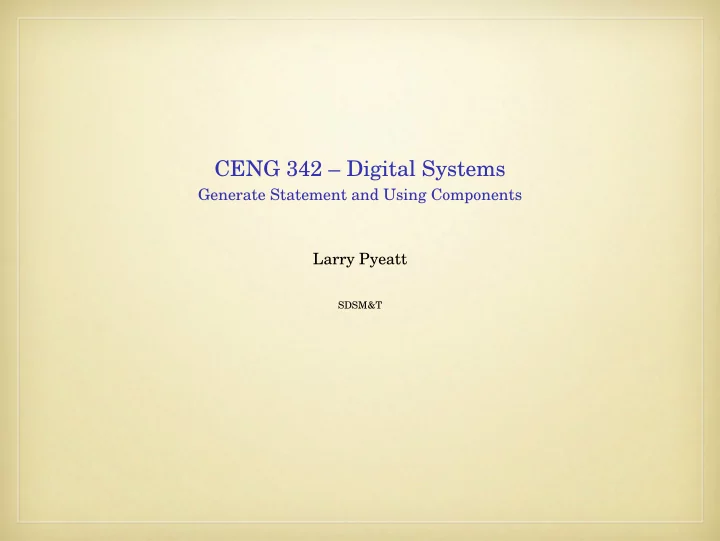

CENG 342 – Digital Systems Generate Statement and Using Components Larry Pyeatt SDSM&T
The generate Statement Allows the programmer to instantiate an “array” of entities/components. Syntax: 1 label: for parameter in range generate concurrent statements 2 3 end generate label; The generate parameter may be used to index array-type signals associated with component ports.
The generate Statement Suppose you have a one-bit register with the following entity definition: 1 entity reg_1_bit is port( din: in std_logic, 2 clk: in std_logic, 3 reset: in std_logic, 4 dout: out std_logic); 5 6 end entity reg; You can now create a generic register that is made up of one-bit registers. 1 entity generic_register is generic(N : natural := 8 ) port(input: in std_logic_vector(N-1 downto 0), 2 clk: in std_logic, 3 reset: in std_logic, 4 output: out std_logic_vector(N-1 downto 0)); 5 6 end entity reg; 7 8 architecture gen of generic_register is 9 begin gen_reg: for I in N-1 downto 0 generate 10 regI : entity reg_1_bit port map 11 (din=>input(I), clk=>clk, reset=>reset, dout=>output(I)); 12 end generate gen_reg; 13 14 end architecture gen;
Components Sometimes it is useful to declare the ports of a device without specifying the entity. The exact entity to be used will be defined later. Think of component as declaring a socket which can accept different entity/architecture pairs (as long as they have the same port mapping). The syntax is the same as the syntax for an entity, but components cannot have architectures.
Component Example – Part 1 1 -- declare a silly little entity and give it an architecture 2 entity exor is port ( 3 in1: in bit; 4 in2: in bit; 5 out1: out bit 6 ); 7 8 end entity; 9 10 architecture arch of exor is 11 begin 12 out1 <= in1 xor in2; 13 end architecture;
Component Example – Part 2 15 -- declare a testbench and give it an architecture 16 entity exor_test is 17 end entity; 18 19 architecture foo of exor_test is 20 component x is -- define a component that matches exor 21 port (a: in bit; 22 b: in bit; 23 c: out bit); 24 end component; -- signals for the test 25 signal a, b, c: bit; 26 27 begin -- instantiate component 28 TARG: x port map (a => a,b => b,c => c); 29 30 STIMULUS: 31 process 32 begin 33 wait for 2 ns; a <= ’1’; 34 wait for 2 ns; b <= ’1’; 35 wait for 2 ns; a <= ’0’; 36 wait for 2 ns; b <= ’0’; 37 wait for 2 ns; a <= ’1’; 38 wait for 2 ns; 39 wait; 40 end process; 41 42 end architecture;
Component Example – Part 3 44 -- create configuration for entity exor_test 45 -- this specifies which entity should be used for component x in 46 -- architecure foo of component exor_test, and of course this 47 -- configuration also has a name: conf 48 configuration conf of exor_test is 49 for foo for TARG: x use entity work.exor(arch) 50 port map ( 51 in1 => a, 52 in2 => b, 53 out1 => c 54 ); 55 end for; 56 end for; 57 58 end configuration conf;
Recommend
More recommend